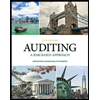
Concept Introduction:
Codes of professional conducts include a list of principles and regulations which define the set of standards of ethic and professional behavior that require for each members of the entity. It gives the general outline for the institute and its members, how they should behave and perform.
To describe: Three theories of ethical behavior that can be used to analyze the ethical issues in accounting
Explanation of Solution
The ethical behavior includes the general outline for the institute and its members, that how they should behave and perform. The theories of ethical behavior are described below:
Utilitarianism: Utilitarianism is an ethical theory that determines the rights things from the wrong one, and indicates that the most ethical decision is one which produces the greatest happiness. In accounting, utilitarianism theory helps to determine both the right and wrong side of a particular action, and focus on the result of the action.
Right-based approach: A right-based approach include that individual should aware of their rights and, he should participate in the government and development policies. It helps them to live their life as they want to live and can claim for their right when needed. So if any decision-maker accepts the theory of right then, he should give respect to each individual’s right.
Justice-based approach: The justice-based approach includes the justices for each individual and makes them confident that everyone can use and better achieve their goals. This approach is used for the better development for the society. This approach assumes that each individual has needs equality while decisions made for them.
Want to see more full solutions like this?
Chapter 19 Solutions
AUDITING & ASSURANCE SERVICES CONNECT AC
- What is the time value of money, and why is it important in financial decision-making?arrow_forwardPlease don't use chatgpt. The formula for calculating the present value of a future amount is:A) Future Value × (1 + r)^nB) Future Value ÷ (1 + r)^nC) Future Value × (1 - r)^nD) Future Value ÷ (1 - r)^n help in this question.arrow_forwardThe formula for calculating the present value of a future amount is:A) Future Value × (1 + r)^nB) Future Value ÷ (1 + r)^nC) Future Value × (1 - r)^nD) Future Value ÷ (1 - r)^n need help!arrow_forward
- no ai What is the primary purpose of diversification in investing?A) To maximize returnsB) To eliminate all riskC) To reduce unsystematic riskD) To ensure stable dividendsarrow_forwardno chatgpt Which of the following is a capital structure decision?A) Deciding how much to pay in dividendsB) Deciding how to allocate funds to various projectsC) Deciding the mix of debt and equity financingD) Deciding how much inventory to purchase need help!arrow_forwardWhich of the following is a capital structure decision?A) Deciding how much to pay in dividendsB) Deciding how to allocate funds to various projectsC) Deciding the mix of debt and equity financingD) Deciding how much inventory to purchasearrow_forward
- No chatgpt!! The weighted average cost of capital (WACC) is used to:A) Measure the profitability of a companyB) Determine the cost of debt financing onlyC) Calculate the company’s average cost of financing from debt and equityD) Estimate the future stock price need help.arrow_forwardNo AI The weighted average cost of capital (WACC) is used to:A) Measure the profitability of a companyB) Determine the cost of debt financing onlyC) Calculate the company’s average cost of financing from debt and equityD) Estimate the future stock pricearrow_forwardCost of Trade Credit A large retailer obtains merchandise under the credit terms of 3/20, net 35, but routinely takes 65 days to pay its bills. (Because the retailer is an important customer, suppliers allow the firm to stretch its credit terms.) What is the retailer's effective cost of trade credit? Assume a 365-day year. Do not round intermediate calculations. Round your answer to two decimal places. The answer is not 27.09 which is incorrect.arrow_forward
- You invest $1,000 a year for 10 years at 6 percent and then invest $2,000 a year for an additional 10 years at 6 percent. How much will you have accumulated at the end of the 20 years? Answer: $49,967 *Please include all work & formulasarrow_forwardNo ai please! What is the role of an underwriter in an IPO?A) To lend money to the companyB) To set the dividend policyC) To buy the securities and sell them to the publicD) To manage the company’s operations need hearrow_forwardNo ai tool What is the role of an underwriter in an IPO?A) To lend money to the companyB) To set the dividend policyC) To buy the securities and sell them to the publicD) To manage the company’s operationsarrow_forward
- Business/Professional Ethics Directors/Executives...AccountingISBN:9781337485913Author:BROOKSPublisher:Cengage
 Intermediate Accounting: Reporting And AnalysisAccountingISBN:9781337788281Author:James M. Wahlen, Jefferson P. Jones, Donald PagachPublisher:Cengage Learning
Intermediate Accounting: Reporting And AnalysisAccountingISBN:9781337788281Author:James M. Wahlen, Jefferson P. Jones, Donald PagachPublisher:Cengage Learning Auditing: A Risk Based-Approach (MindTap Course L...AccountingISBN:9781337619455Author:Karla M Johnstone, Audrey A. Gramling, Larry E. RittenbergPublisher:Cengage Learning
Auditing: A Risk Based-Approach (MindTap Course L...AccountingISBN:9781337619455Author:Karla M Johnstone, Audrey A. Gramling, Larry E. RittenbergPublisher:Cengage Learning


